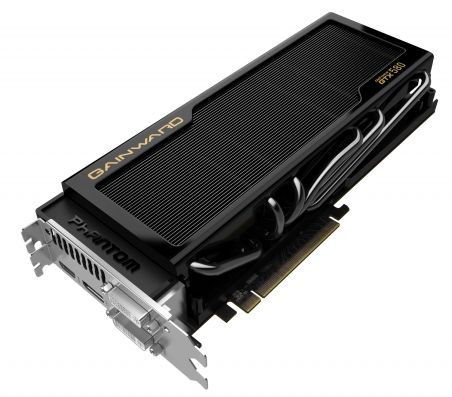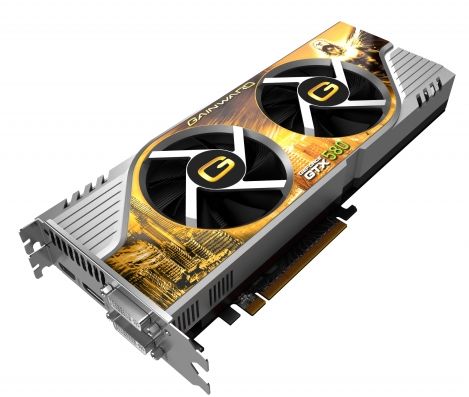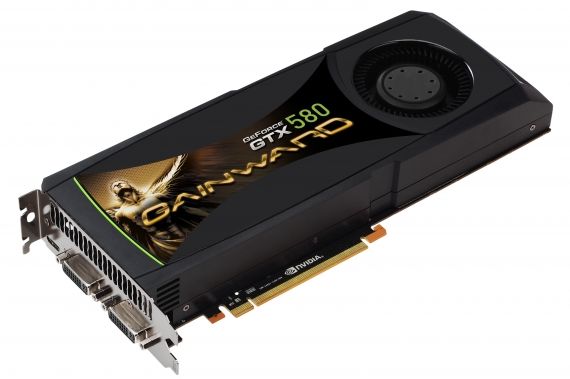Index

Review: Running cool and armed with 3GB
Gainward recently started its Phantom series, for users who crave reliable and quiet cooling to go with good performance. The Phantom series currently features GTX 580, GTX 570 and GTX 560Ti. Our guest today is GTX 580 3GB Phantom, a custom version that as the name suggests comes with Phantom cooling and 3GB of GDDR5 memory. We hope that the strongest Phantom of them all will leave good impression like the GTX 560 Ti Phantom, which we tested here.
We expected to see a higher overclock on GTX 580 3GB Phantom, but it appears like Gainward did not want to step on GTX 580 Golden Sample’s toes. In comparison, Gainward’s GTX 580 Golden Sample runs at 805MHz for the GPU whereas GTX 580 Phantom’s GPU is at 783MHz.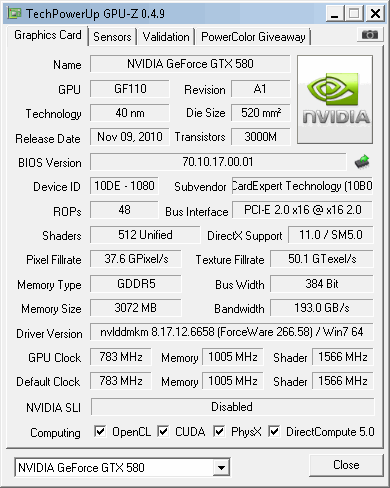
Before we move on to the Phantom card’s description, we’ll showcase Gainward’s current offer based around the currently fastest graphics chip – GF110.
Gainward GTX 580 Golden Sample

Gainward GTX 580 3GB Phantom looks great, but more importantly – the graphics card sports quiet cooling, whose performance is good enough to cool down the fastest GPU up to date, GTX 580 (GF110). At first glance one may suggest that the Phantom is passively cooled, but one would of course be wrong. Three 80mm fans are placed under the heatsink and are barely visible from the outside.
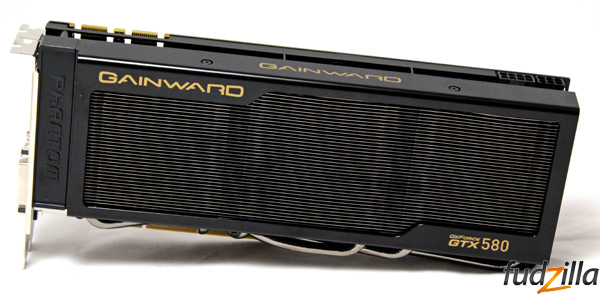
A large aluminum heatsink in a black plastic frame covers the entire card, and the hefty dissipating surface helps to provide good cooling performance. However, placing fans between the heatsink and the cooler’s base does introduce one disadvantage - the card is 2.5 slots wide. We can’t really pick hairs though, as the cooler does its job really good and it remains quiet all the time. The card is 10.5 inches (267 mm) long, same as the reference card.
A six-heatpipe system is used to take care of heat transfer between the cooler base and the heatsink. As you can see from the picture below, some heatpipes stretch to the farthest end of the heatsink.
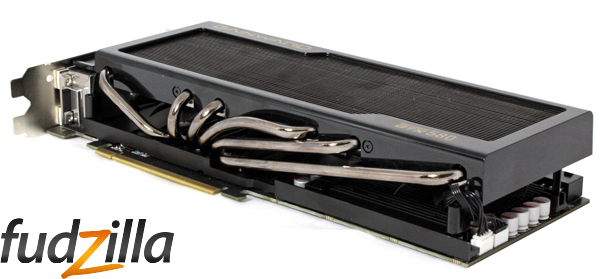
As we mentioned before, Phantom’s cooler is equipped with three fans but there are only two 4-pin power connectors on the PCB.

Two fans share the same 4-pin power connector, whereas the third fan is connected on its own connector. However, this is not as important because the driver will take care of setting the same RPM for all fans. Setting the RPM manually is a breeze using Gainward’s ExperTool or any other popular utility like MSI Afterburner.
The next picture shows how cable routing was implemented.

The heatsink features clean design without sharp edges. The welds between heatpipes and aluminum fins were done well.
Pulling cold air through the heatsink is the main task for the three fans, but they are in charge of cooling hot components on the PCB too.

Removing the cooler from the card will not be an easy task. Usually, this is done by removing four spring-loaded screws from the card’s back side, but this time you will have to remove all the other screws as well.

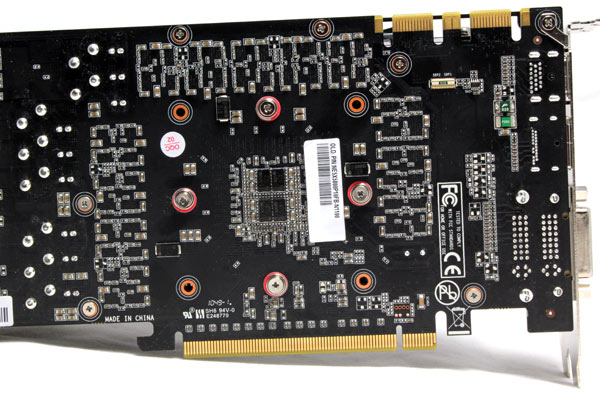

The cooler base is fastened to the black metal plate by two clips. Contact area to the GPU does not feature mirror finish.

Gainward uses Power Logic PLA8015S12HH fans with maximum RPM of about 3500.

As you can see from the picture below, the big metal plate covers all the shorter electrical components on the PCB, such as memory modules.
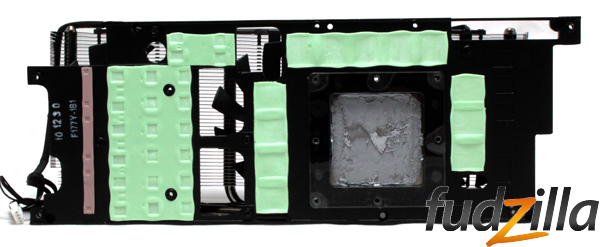
Taller components, including the six phase VRM (power regulation module) for the GPU and two phase VRM for the memory, are cooled directly by the air from the fans above.

GTX 580 Phantom is equipped with a total of 3072MB video memory.
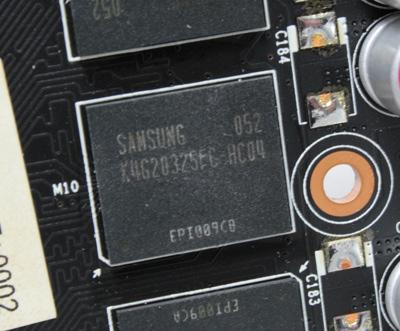
As far as video outs go, we have here the classic Gainward’s Quattro-ports design, i.e. two dual link DVIs, HDMI and DisplayPort out. Note that only two video outs can be used simultaneously. Nvidia included an HDMI sound device within the GPU, so there is no need for connecting the card to your motherboard’s/soundcard’s SPDIF out to get audio and video via HDMI.

This card requires two PCI Express power connectors - one 6-pin and one 8-pin. It supports both 2-way and 3-way SLI configurations.
Integrated power Control IC is placed at the back of PCB - ON Semiconductor's ADP4100 IC was used.
GTX 580 Phantom’s packaging is large but sturdy. As you can see from the picture below, the larger box (GTX 580 Phantom) says Phantom 3, meaning three fans, while the smaller box (GTX 560 Ti Phantom) says Phantom 2, meaning two fans.



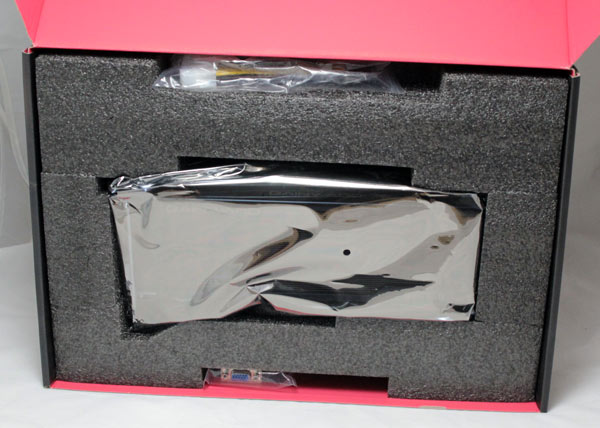
The box contains one DVI-to-VGA convertor, one dual 6-pin to single 8-pin PCI Express power adapter, a quick start guide, a driver CD and a discount coupon for Loiloscope.
Testbed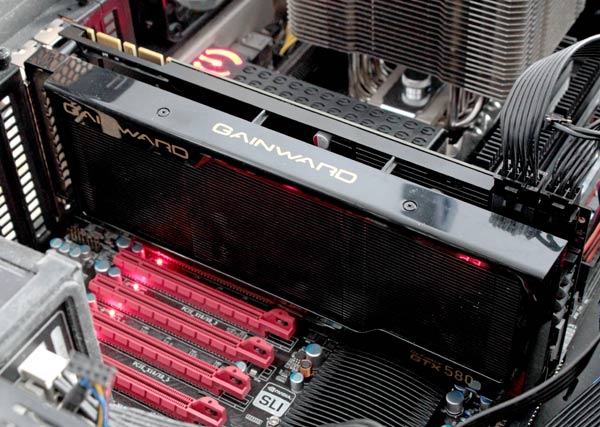
Motherboard: EVGA 4xSLI
CPU: Core i7 965 XE (Intel EIST and Vdrop enabled)
Memory: 6GB Corsair Dominator 12800 7-7-7-24
Harddisk: OCZ Vertex 2 100 GB
Power Supply: CoolerMaster Silent Pro Gold 800W
Case: CoolerMaster HAF X
Fan Controler: Kaze Master Pro 5.25"
Operating System: Win7 64-bit
266.66_desktop_win7_winvista_64bit
11.1 CCC
3DMark Vantage

3DMark 2011
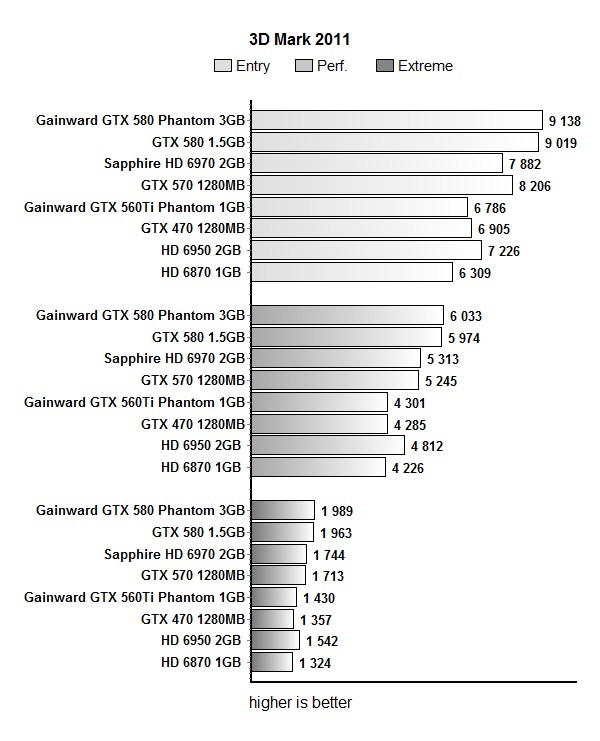
Aliens vs Predator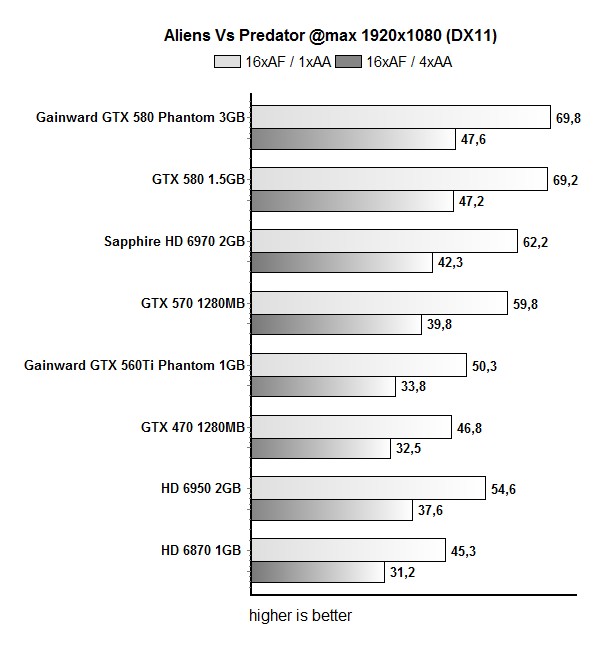
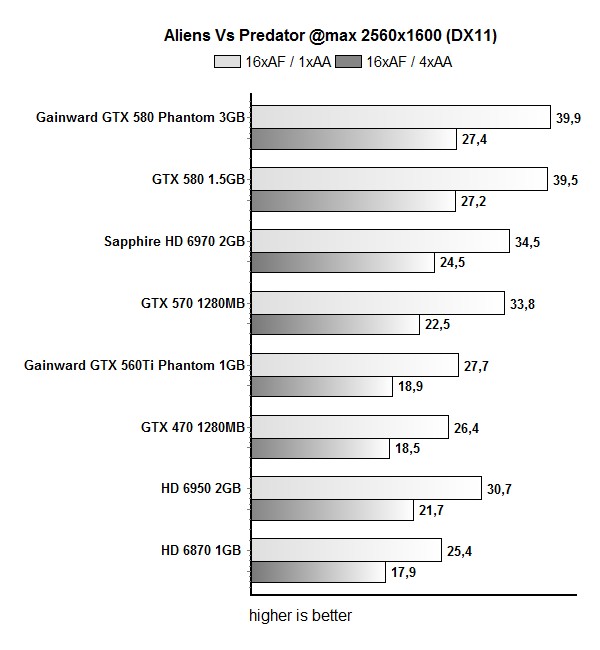
Dirt 2

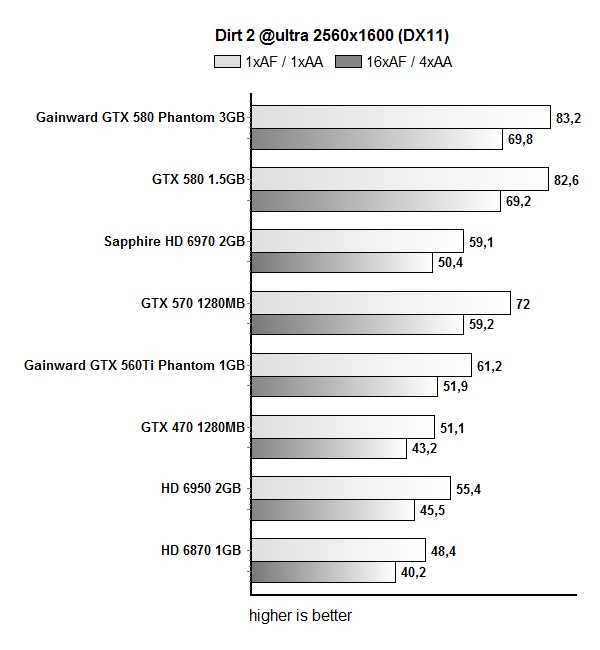
Metro 2033

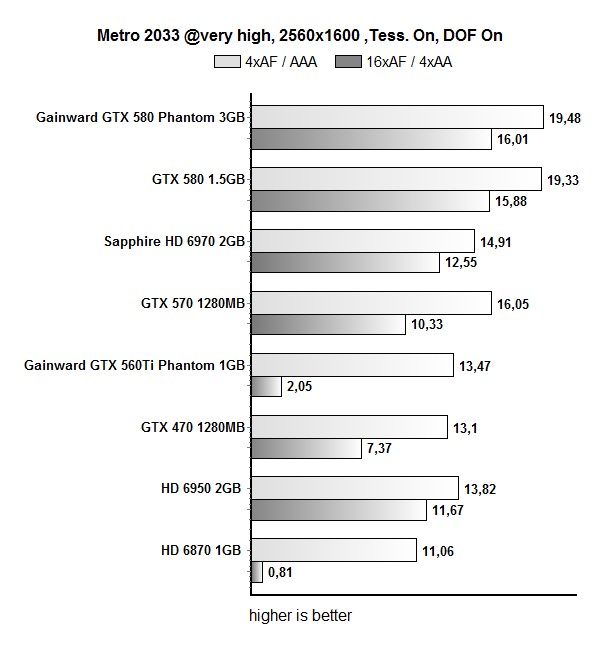
Unigine Heaven

TessMark

Overclocking
We must admit we expected better OC potential from GTX 580 3GB Phantom. Although it is possible to meddle with GPU voltages, it didn’t help us achieve stable operation beyond 880MHz.
Note that we managed to push the GPU to 940MHz using voltage of 1250mV and we even did some gaming, but pixel error free image was only possible at 880MHz. Maximum memory clock was 2140MHz (4280 effectively).
Temperatures and Noise
We know that the card owes its name to the Phantom cooling but Phantom will definitely not have an easy task fighting Nvidia’s pretty nice reference cooling. When idle, Phantom is almost inaudible. When the card is under load, you can hear the three fans but the “loudness” is within acceptable levels. Truth be told, Phantom is slightly louder than reference cards when under load, but in turn provides 9°C lower temperatures. You can always manually decrease the RPM at the expense of thermals and Gainward’s Phantom definitely has headroom for experimentation and finding your ideal settings.
Power Consumption
Gainward’s GTX 580 3GB Phantom will consume about 20W more than the reference cards, which is a result of the slight overclock.
Conclusion
A few days ago, Gainward announced the GTX 580 Phantom card, which boasts 3GB of GDDR5 memory and comes with a rather unique custom cooler with three 80mm fans, six heatpipes and a large aluminum heatsink with a copper base.The factory overclock is really only slight - GTX 580 Phantom comes with 512 CUDA cores and runs at 783MHz for the GPU, 1566MHz for shaders and 4020MHz for 3GB of GDDR5 memory paired up with 384-bit memory interface.
We recently tested Gainward’s GTX 560 Ti Phantom card, here, and liked it a lot. However, it appears like we’ve had too high expectations for the GTX 580 Phantom, as it didn’t quite score that well.
Truth be told, GTX 580 3GB Phantom’s cooling performance is better than that of reference cooling – we measured up to 9°C lower GPU temperatures. However, the cooler is a bit louder than the reference solution. That’s not to say that Phantom is loud, it’s actually within acceptable levels. However, we’d much rather see a card quieter than the reference version. After all, we’re talking about a two and a half slot wide cooling that’s expected to deliver bigtime.
Gainward GTX 580 3GB Phantom runs at slightly higher clocks that will not really affect performance. However, the card is still the fastest single-GPU graphics card around and will chew up any game with ease. If you need more than 1.5GB of memory then this is the card for you as it packs 3GB of GDDR5. Note however that the added memory won’t help much if you’re playing on one display, although some games might find some use for it at 2560x1600 (32x AA and 32x AF). This means that dual-display gaming will probably be the wisest application for the frame buffer.
Gainward did a good job with Phantom series, which already attracted much attention among enthusiasts. All the cards from Phantom series look good but cooling performance and noise levels are even better. The only thing that might raise eyebrows is the pretty steep price of €520, here, which is in our eyes a bit too much. However, if you’ve got green to spare, make no mistake – this card will provide serious performance, and then some.

